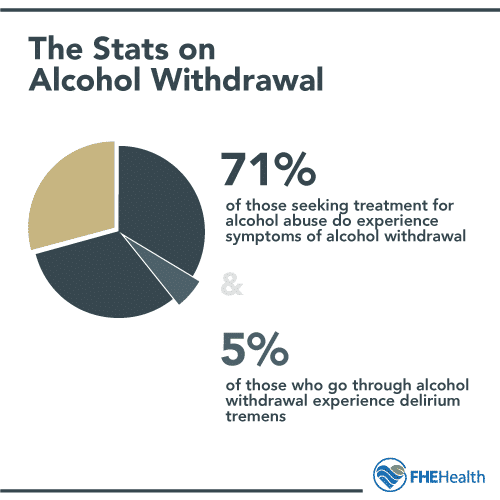Stages of Alcoholism, Withdrawal, Delirium Tremens
Alcohol is a substance that is widely accepted in most cultures and is legal in most countries as well. But it is also a poison, and if abused and mistreated, it carries with it many symptoms, side effects, and consequences. Even though alcohol is used as a social lubricant at many sporting events, work parties, and holiday get-togethers, it is still something that can ruin people’s lives, and consistent binging or abuse can lead to a disease called alcoholism. Like any serious disease, the stages of alcoholism can be deadly if not treated properly and with serious medical attention. People who try to quit alcohol cold turkey can experience serious withdrawal symptoms.

The stages of alcoholism can get so bad one starts to experience signs of delirium tremens when they try to stop drinking, turning into full blown hallucinations. Unlike hard narcotics like heroin, cocaine, and methamphetamines, alcohol withdrawals can be fatal in some cases. According to USA Today, “for those experiencing the most serious symptom of withdrawal – the shaking, shivering, sweating and confusion of delirium tremens, or the DTs – the death rate has been estimated as high as 4 percent, or 1 in 25.” (1)
Despite these figures, people still drink high amounts of alcohol to the point of being intoxicated, sometimes on a binge drinking schedule for a couple days every week, others drinking a moderate amount every day. Either way these can be the start of the stages of alcoholism, which in turn can end with the signs of delirium tremens when trying to withdraw. But what are the exact stages of alcoholism? How long does it take for alcohol withdrawal to start? And what are the signs of delirium tremens?
What is Fentanyl?
Fentanyl is prescribed by doctors to treat chronic cancer pain, nerve damage, back injury, major trauma, and surgery post-op pain. Medicinally, it’s available in many forms. In transdermal patch form it’s called Durogesic and APO-fentanyl. Some people take it like a cough drop you suck on, which are called lozenges and sold under the name Actiq. Lastly, it can be taken intravenously, under the name Sublimaze and B.Braun Fentanyl (3). Fentanyl is a synthetic opioid and is also produced on the black market.
Opioids, from morphine to Fentanyl, “work by binding to the body’s opioid receptors, which are found in areas of the brain that control pain and emotions. After taking opioids many times, the brain adapts to the drug, diminishing its sensitivity to the substance, making it hard to feel pleasure from anything besides the drug.” (4) There are many side effects of Fentanyl, including, confusion, sedation, nausea, drowsiness, extreme happiness, constipation, problems breathing, and unconsciousness.
Stages of Alcoholism
Alcoholism, or in medical terms, alcohol use disorder, is a chronic disease. One who suffers from an alcohol use disorder cannot control their drinking and has a preoccupation with alcohol. But what are the stages of alcoholism? The stages of alcoholism develop slowly in some, and rapidly in others. Moderate drinkers usually don’t have to worry about the stages of alcoholism, as long as they keep their drinking to a minimum. But those with an alcohol use disorder will go through the stages of alcoholism. The National Institute on Alcohol Abuse and Alcoholism estimates that 17 million American adults have alcohol use disorders.
Another 855,000 Americans ages 12 to 17 years old have alcohol use disorders. (2) The first sign of an alcoholic is someone who constantly binge-drinks, meaning they drink five or more alcoholic drinks in an hour. Binge drinking can take place in one night or over several days. Regardless of how long it is, it shows an inability to control one’s drinking, and can cause alcohol poisoning, or death. Once someone frequents binge drinking, they might start to drink every weekend or most days of the week. They fit their lifestyle to revolve around their drinking, including setting up frequent meet-ups with friends so they have an excuse to drink, or simply drink by themselves because they feel they have nothing else to do.

This is when their drinking can turn into having serious problems, like not showing up to work, not being there emotionally and physically for their partner and family, and avoiding situations where they can’t drink as much as they want to. Someone who is experiencing these signs will more than likely reach the next stage of alcoholism, which is dependence, either physically, mentally, or both. You need more alcohol because of the tolerance you built up and need alcohol to feel physically normal.
You think about alcohol even when you’re not drinking and are waiting for the next time you can drink. The final stage of alcoholism is addiction, meaning you are constantly seeking out chances to drink, even against your own will. You will drink when you shouldn’t and can’t experience joy without drinking. You simply cannot control your desire and ability to drink. One might try to stop cold turkey, but withdrawal symptoms include their own set of possibly excruciating hurdles, including delirium tremens, sweating, irritability, and a racing heart. (3) But what are the signs of delirium tremens? And how long does it take for alcohol withdrawal to start?
Check Your Insurance Coverage for FREE
Find out if your insurance covers addiction treatment in minutes. We accept most insurance!
How Long Does It Take for Alcohol Withdrawal to Start?
If you or someone you know has a serious drinking problem, you might think it smart to quit immediately. You might be wondering, how long does it take for alcohol withdrawal to start? It’s never smart for an alcoholic to stop cold turkey. Alcohol withdrawals can be fatal if not treated properly. But how long does it take for alcohol withdrawal to start? In some cases, it can start from a few hours after your last drink. In determining how “long does it take for alcohol withdrawal to start” in an individual, factors like age, gender, health before and during drinking, family medical history, and how much alcohol is consumed and at what rate come into play. Some drinkers will not have to worry about how it takes for alcohol withdrawal to start because they never crossed the line into physical dependence. For more serious cases though, withdrawal symptoms include headaches, sweating, feeling on edge, and the worst being delirium tremens.
Reach out to Hotel California by the Sea
We specialize in treating addiction and other co-occurring disorders, such as PTSD. Our Admissions specialists are available to walk you through the best options for treating your addiction.
Signs of Delirium Tremens
The signs of delirium tremens are vast, but some are very serious and can be deadly if not treated correctly. Early signs of delirium tremens include excitement or fear, bursts of energy, sensitivity to light, sound, and touch, sleepiness, and fatigue. Some later and more serious signs of delirium tremens include profound confusion, autonomic hyperactivity, and cardiovascular collapse, though it is often characterized by intense shaking. (4) Delirium tremens is perhaps the last stage of a serious alcohol withdrawal, brought about when someone who has an alcohol addiction tries to stop cold turkey. It is never suggested that anybody who drinks everyday or binge drinks at a high rate never quit on their own. Detox centers, rehabs, and clinics are set-up to treat severe alcoholism, and can make the withdrawal process a less harsh experience.
References:
- Hundreds in the United States die each year from alcohol withdrawal (usatoday.com)
- Stages of Alcoholism: When Is It A Problem? (healthline.com)
- Stages of Alcoholism: When Is It A Problem? (healthline.com)
- Can You Die from Alcohol Withdrawal? Here’s What to Know (healthline.com)
- What Is Delirium Tremens? | The Hope House
